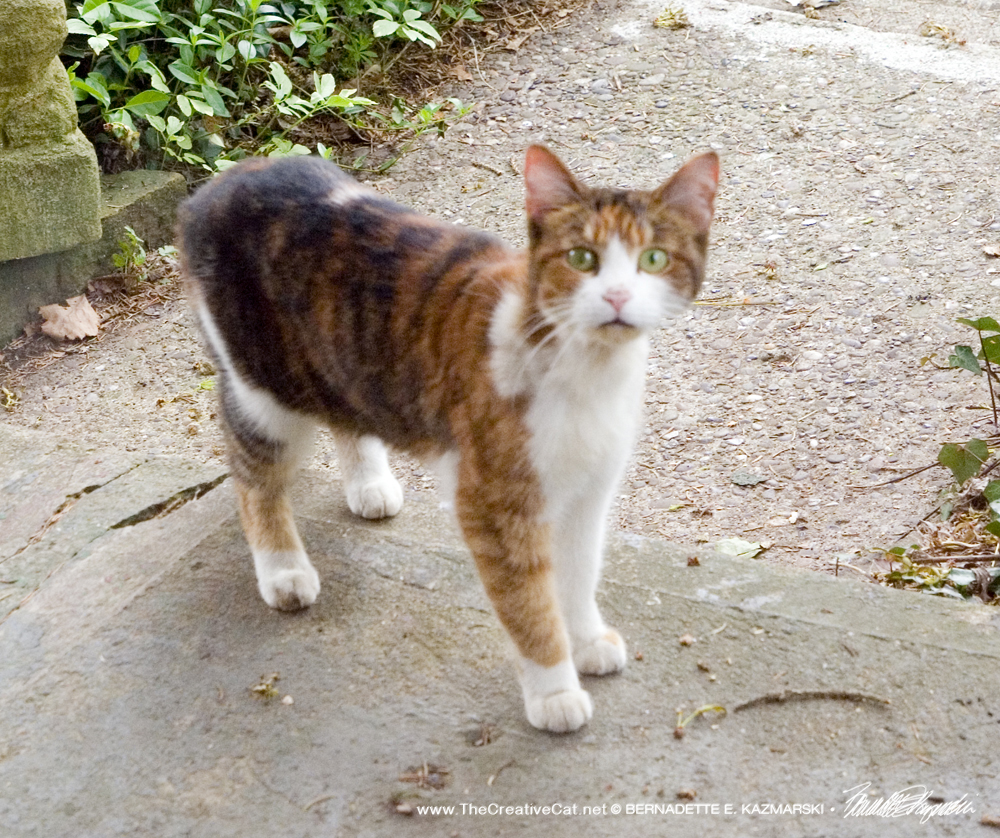So There’s a Nice Cat At Your Door

It’s hard to resist a pretty and friendly cat, especially when they stand out there and look in at you so hopefully, sometimes for days on end. They are hungry, they just want to come inside and rest, and you’re sure they’ll be a good cat.
Or you found a kitten and it’s all alone and you know it needs company, and your cats love kittens. The kitten would do so much better with your cats to play with it and wash it and let it cuddle with them.
And if you give in, it could be the worst mistake of your life, and your cats’ lives.
I still hear of people who take in a friendly cat and let it mingle with their household, happy at how well they get along, believing because it is friendly and social and looks healthy, it is.
Even though that cat you found is so friendly or that kitten is so cute, and they all look fine and healthy, not even your veterinarian can look at a cat and tell if it’s carrying a contagious illness. Never add a cat whose health history you don’t know to the mix in your household without an observation period in a quarantined area, and a visit or consultation with a veterinarian. Blood tests need to be done, and time needs to pass for possible illnesses to incubate and symptoms to appear. If you need to take the cat in, you can safely quarantine the cat and observe it as well as make an appointment with a veterinarian.
You need to be aware of the possible illnesses they could be carrying and how they are spread, which can happen even with the cat standing at your screen door nose to nose with your own cats. Even if your cats are current on their core vaccines, there are diseases that can’t be vaccinated against, and diseases like FeLV are not often given to cats who don’t go outdoors.
Among the most dangerous and most easily transmitted are:
- feline distemper
- feline leukemia virus (FeLV)
- virulent systemic feline calicivirus (VS-FCV)
- rabies
A cat can be carrying any one of these, including rabies, and not show any symptoms at all, and can be spread by casual contact—a sneeze, sharing food or water, mutual grooming.
Cats are not vaccinated against everything
Yes, even a tiny kitten could be carrying a potentially fatal contagious illness and pass it on to your household. There is even a danger to an unrelated nursing mother cat and her original litter if a stray kitten is put with her to nurse but is carrying an infectious disease.
If your cats are up to date on vaccines, the FVRCP vaccine cats are given protects against feline distemper, upper respiratory infections and normal feline calicivirus but not the virulent strain. If the kitten’s mother had been vaccinated chances are she would have passed the immunity on to her kittens while they were nursing. However, if the mother cat had been abandoned and never received any vaccinations, which is often the case with young cats abandoned with kittens, the mother and her kittens could easily become infected, and if the kitten is older than eight weeks it’s generally past the age for immunity derived from its mother.
Cats are not vaccinated against Feline Leukemia Virus (FeLV) and Feline Immunodeficiency Virus (FIV) unless you request it, and if they are indoor cats and unlikely to encounter either illness veterinarians, along with the American Veterinary Medical Association (AVMA) and American Association of Feline Practitioners (AAFP) don’t recommend it.
Rabies vaccine is not administered until 12 weeks, and unfortunately several stray kittens are found each year to have rabies.
Incubation periods, and cats hiding symptoms
Upper respiratory infections may take a week to 10 days to show symptoms.
Feline Leukemia Virus (FeLV) can take up to 30 days and Feline Immunodeficiency Virus (FIV) can take up to 60 days to incubate after infection so testing immediately isn’t always accurate, and tests on kittens younger than eight weeks are not always reliable.
Cats are masters at hiding illness, and few of us know all the symptoms of all the illnesses they could be carrying. Second, incubation periods and contagious periods vary. A cat you’ve been feeding in your back yard may have no vaccine immunity to contagious illnesses, and the day before you take her in encountered a cat with distemper or FeLV. You think she’s fine because you know her. Days or weeks can pass before you see any symptoms, yet in that time she can be developing or shedding a disease. Unless you’ve contained the cat or observed it every moment while outside, never presume you know all its activities.
Parasites
Illnesses may seem to be more urgent, but parasitic infestations can not only cause as much damage to a cat as an illness, but if a stray cat brings them in all cats in the house, as well as the house itself in some cases, would need to be treated for fleas, roundworms, hookworms, tapeworms, earmites and more.
Quarantine periods
Personally, I quarantine no matter where a cat has come from for both health and social reasons, even if it has vet records and I know its personality. From the shelter, someone’s home, the street, no matter where the cat came from, I observe for any signs of illness as latent illnesses can appear from the stress of a move to a strange place. I also assess its personality and actions toward me to form a bond with it and anticipate how the cat will react when introduced to my household. Anything that makes that transition easier is valuable.
I quarantine completely for at least two weeks and watch carefully for any symptoms that appear, then loosen things up a bit after two weeks if I know the foster’s health history. Two weeks is enough time to see symptoms develop from a URI and many other common viruses that may be latent even if the cat encountered it the day they came in. It’s common for cats and kittens to develop a little sneeze or runny eye that’s usually related to stress rather than illness and if so you can watch to see if it passes on its own. I also let my veterinarian know I have rescued yet another cat so that she knows I may call with questions about a cat she’s never seen, and if I’ll be contacting her it will likely be in that initial two weeks.
The cat is still there, so what should you do?
The first thing you should do is take the cat’s photo and let the world know it’s there in case it’s lost and someone is desperately looking for it. Share it on social networks, make a flyer and post it around your neighborhood and let the shelters know.
If an adult and you can handle the cat, take it to a local veterinarian or shelter and have them check it for a microchip.
If you have no place for a safe quarantine in your home or any other area, you can set up a safe feeding station for the cat in a sheltered area. Always keep water available, feed once or twice a day and take the food in at night to help avoid feeding wildlife or rodents. Wash the bowls regularly—even the residue from dry food can attract other animals and insects, and the residue of saliva can easily breed bacteria. Keep the feeding area clean and free of food debris.
Contact a shelter or rescue, or your own veterinarian, and make arrangements for the cat or kitten to be examined and tested to the extent it can be.
If the cat is well and has no safe place to go, you can either choose to foster it for a shelter or rescue, or take it in, safely, and observe and then slowly introduce the new cat to your household.
~~~
Also read Fostering Rescued Cats and Kittens, Part 1 and Part 2.
The pretty calico at the top is Lily Rose, who belongs to a neighbor, which took a while for the neighborhood to figure out. She is quiet and sweet and very nice, just the sort of cat you’d want to bring in.
Read more articles in the category Health and Welfare
Gifts featuring cats you know! Visit Portraits of Animals
Fine Art • Photography • Gifts • Greeting Cards • Books • Commissioned Portraits & Artwork
Pittsburgh C.A.T. 2019 Calendar: Rescue, Foster, Rehome, Repeat 2019

Each month features a cat or cats and the story who Pittsburgh C.A.T. volunteers rescued through TNR or rescue from abandonment, neglect or abuse, offered medical treatment, fostering, socialization, and a loving forever home that met their individual needs. Read more and purchase.

Copyright
All images and text used on this site are copyrighted to Bernadette E. Kazmarski unless otherwise noted and may not be used without my written permission, although links to your site are more than welcome and are shared. Please ask if you are interested in using and image or story in a print or internet publication. If you are interested in purchasing a print of an image or a product including it, check my animal and nature website Portraits of Animals to see if I have it available already. If you don’t find it there, visit Ordering Custom Artwork for more information on a custom greeting card, print or other item.
Subscribe to my e-newsletter
Subscribe to The Creative Cat Preview E-newsletter.
© 2022 | www.TheCreativeCat.net | Published by Bernadette E. Kazmarski
Weekly schedule of features:
Sunday: Essays, Pet Loss, Poetry, The Artist’s Life
Monday: Adoptable Cats, TNR & Shelters
Tuesday: Rescue Stories
Wednesday: Commissioned Portrait or Featured Artwork
Thursday: New Merchandise
Friday: Book Review, Health and Welfare, Advocacy
Saturday: Your Backyard Wildlife Habitat, Living Green With Pets, Creating With Cats
And sometimes, I just throw my hands in the air and have fun!



Like you, I’ve learned from my own bad experiences. I now keep all cats isolated for at least 60 days then test them. If they are clear then they can enter my family. Of course during that isolation period your present cats are getting used to any noise or smells from the new cat too so socialization is so much easier when the time comes.
Excellent article! Great information.
noe joke; eye waz in quaranteenz for cloze ta 90 dayz….either de food servizz gurlz paranoid;
her iz,.. eye haz lurned that; ore de food servizz gurlz paranoid…..eye arrived when de A/C
waz on N dinna get outta sol a tarry til de heet terned on { much ta de big katoonaz dizguzt !! 😉
mackerull ♥♥♥
This was an eceptionally good piece. I have learned through my mistakes over the years to quarantine for no less than two weeks. The majority of our cats through the years have been strays.
Thanks, Janet. The last time I just opened the door and let a cat in was 1986 when Stanley finally convinced me. I shiver to think of all the times before that. Mine have all been strays and rescues but some early vets managed to break me of that bad habit way back then and I’m so glad seeing what some of them came in with. Thanks for rescuing strays!